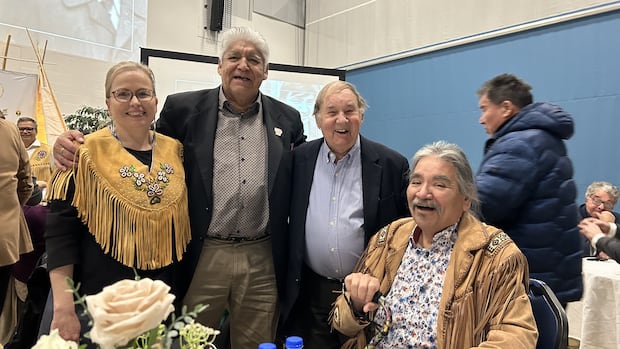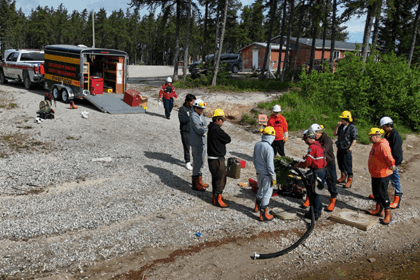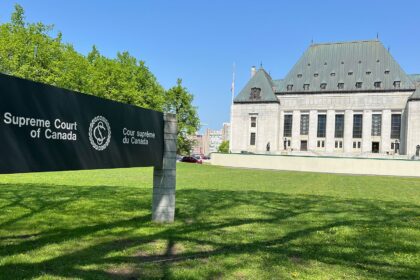Hundreds of Cree from across Eeyou Istchee gathered on Tuesday in Chisasibi, Que. — the largest Cree community — to reflect on 50 years since the signing of the James Bay and Northern Quebec Agreement (JBNQA).The day included people such as Daisy House, chief of Chisasibi, and Mandy Gull-Masty, the former grand chief of Eeyou Istchee and now federal minister of Indigenous Services, along with many others. The commemoration included stories from negotiators and signatories, reflections, and hope for the next 50 years of the JBNQA.The land claim agreement was signed on Nov. 11, 1975, by the Quebec and federal governments, and Cree and Inuit representatives.For Chief House, Tuesday’s anniversary was a day of reflection about how far the Cree have come since then.“Just the changes and where we’ve come from, where we are now and where we wish to go. That’s my reflection,” said House.Throughout the day at the Mitchuap and the Big River High School, people reunited with relatives and friends from other communities, embraced old acquaintances, and remembered those who have since passed on.House said elders played a crucial role during the signing of the JBNQA, offering foresight about what development could mean for the land and helping young negotiators like Billy Diamond, Phillip Awashish, and Robert Kanatewat to lead and work to ensure Cree people had rights and benefits throughout Eeyou Istchee.James O’Reilly, left, a lawyer who had helped represent the Cree, with Robert Kanatewat, one of the agreement’s last living signatories, in Chisasibi on Tuesday. (Vanna Blacksmith/CBC)“They saw the damage that could happen with the flooding of our rivers and lakes and the disappearance of the mountains,” said House.Even though the Hydro-Québec dams represented modernization, elders worked to safeguard the land as much as possible so future generations could continue living the Cree way of life.“They knew the massiveness of the project because they walked that land, portaged, paddled, even dog sled. I’m in awe of what they were able to do during that era,” said House.The Cree Nation of Chisasibi, home to about 5,000 people, is the largest community in Eeyou Istchee. Chisasibi is home to eight of the 11 Hydro-Québec dams and according to House, made the greatest sacrifices to support the rest of the Cree Nation.Robert Kanatewat, one of the last living signatories, spoke at Tuesday’s event, greeting and hugging people. He also thanked James O’Rielly, one of the lawyers who helped represent the Cree during the signing. “I’m thankful … that I was able to be here personally, see and think back about what we did and why,” said Kanatewat.Robert Kanatewat in his home in Chisasibi. (Vanna Blacksmith/CBC)Kanatewat added that signatories shared a special bond, and he wished that those who were no longer around could see how far Eeyou Istchee has come. “The agreement is not perfect, but it’s an agreement that we will be able to survive off, if we continue to do the right thing,” said Kanatewat.He said that even though they didn’t get all that was aimed for, they managed to “get the crucial points, to roam the territory to hunt, fish, gather.”He says that while the agreement may be seen as good and bad, that there’s always room to change and grow. “Carry on from where the old elders did and the old leaders have left. Be the person to be able to carry it on for the next generation,” said Kanatewat.That message was echoed by Jimmy R. Fireman, a local Cree man from Chisasibi who has worked with elders for the past 13 years, organizing activities and listening to their stories.“The traditional elders, a lot of them, didn’t speak English, just Cree. They’re in their 80s and 90s. Some have passed away. Soon, we won’t have them anymore,” said Fireman.While many spoke about changes in Eeyou Istchee — such as education, economic development, health, and self-governance — Fireman reflected on how generational shifts are also transforming the community’s elders.“The new elders that will take their place are the residential school generation, they’re in their 60s and 70s but are different breed elders, they had an education and professions,” said Fireman.’I’m ready to retire. And if there’s a young person that will take over my job, I’ll teach them how to do it,’ said Jimmy R. Fireman. (Vanna Blacksmith/CBC)Fireman hopes youth and adults take advantage of the time and knowledge the elders still have to share. Even with all the change, Fireman said he chooses to focus on what’s been gained.“We should concentrate on the positive,” said Fireman.He recalled growing up on Fort George Island, facing hardship and scarcity, but also peace and freedom while out on the land with friends hunting small game. Today, he continues to enjoy time on the land and in the community.“I can stay in the bush, I can stay down south, I can stay here,” said Fireman.Mandy Gull-Masty said she was happy to reunite with fellow Cree since beginning her new role as a federal minister. “There’s a lot of people that would have been here today celebrating with us. So for me, it’s also a reflection of the people that have left us and what they’ve contributed to this process,” said Gull-Masty.’We are very unique. We are one of the Nations that has the language, that has connection to the land, that has the capacity to negotiate at the highest levels of government,’ said Mandy Gull-Masty, the federal minister of Indigenous Services, in Chisasibi on Tuesday. (Vanna Blacksmith/CBC)She paid tribute to mentors who once guided her as a summer student with the Cree Nation Government, local band office in her teen and young adult years. She spoke about Philip Awashish, Robert Kanatewat, Smalley Petawbano, Robbie Matthew and others who were influential in her life.She said every Cree person plays a role in the Nation’s future, not just elected officials.“People who know how to do traditional hunting techniques, traditional knowledge, and language carriers — In the future, these people are going to be the most valuable for our Nation,” said Gull-Masty.Gull-Masty said the future of the Cree Nation depends on youth understanding their rights and continuing to build on the foundation set by past generations.“We are very unique. We are one of the Nations that has the language, that has connection to the land, that has the capacity to negotiate at the highest levels of government,” she said.She added that continued growth—economic, social, and cultural—is essential to keep that momentum going.“When we are continuing to evolve and grow like we did with our agreement, the future is really limitless,” said Gull-Masty.Daisy House, chief of Chisasibi, Tuesday’s anniversary was a day of connection, remembrance, and honour, and a time to reflect on the past and future. She recalled her nearly 20 years in Cree leadership, and also spoke about being a young woman in the ’90s and about the same age as the original JBNQA signatories.“Could I have done what they did? Absolutely not. But with guidance from the elders, land stewards, and Cree tallymen — then yes, because I would have listened to them. That’s what our leaders did back then,” she said.
Thursday, 13 Nov 2025
Canada – The Illusion
Search
Have an existing account?
Sign In
© 2022 Foxiz News Network. Ruby Design Company. All Rights Reserved.
You May also Like
- More News:
- history
- Standing Bear Network
- John Gonzalez
- ᐊᔭᐦᑊ ayahp — It happened
- Creation
- Beneath the Water
- Olympic gold medal
- Jim Thorpe
- type O blood
- the bringer of life
- Raven
- Wás’agi
- NoiseCat
- 'Sugarcane'
- The rivers still sing
- ᑲᓂᐸᐏᐟ ᒪᐢᑿ
- ᐅᑳᐤ okâw — We remember
- ᐊᓂᓈᐯᐃᐧᐣ aninâpêwin — Truth
- This is what it means to be human.
- Nokoma










